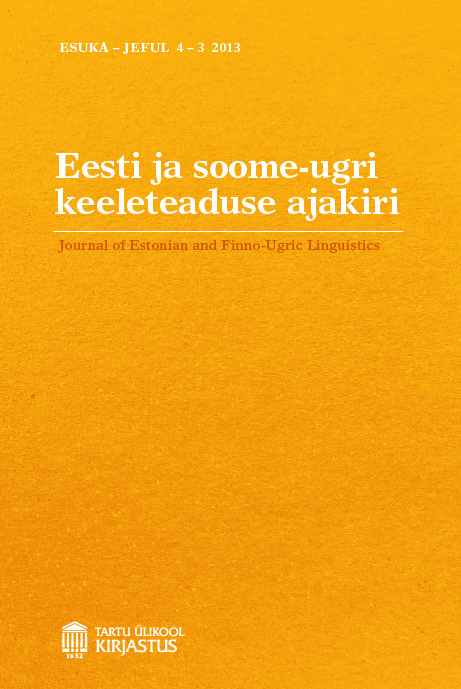Edela-Eesti kohad ja keel Salomo Heinrich Vestringi sõnaraamatus
DOI:
https://doi.org/10.12697/jeful.2013.4.3.05Keywords:
eesti murded, liivi keel, eesti kirjakeele ajalugu, läänemeresoome keelte ajalugu, kohanimed, sõnavara, ajalooline fonoloogia, ajalooline morfoloogiaAbstract
Artikkel käsitleb Salomo Heinrich Vestringi eesti-saksa sõnaraamatut „Lexicon Esthonico Germanicum”, mis on koostatud 18. sajandi alguses ja ilmus trükituna esmakordselt alles 1998. aastal. Vestring sündis Pärnus ja töötas enamiku oma elust seal pastorina. Sellepärast on ootuspärane, et sõnaraamat kajastab suuresti tollast Pärnu ümbruse ja laiemalt Edela-Eesti keelepruuki. Artiklis käsitletaksegi sõnaraamatus esivaid Edela-Eesti kohanimesid, muud sõnavara ning fonoloogilisi ja morfoloogilisi erijooni. Ilmneb, et suurel osal sellest sõnavarast ja grammatilistest erijoontest on vasted ka liivi keeles, eriti Põhja-Lätis kõneldud Salatsi liivi keeles. Vestringi esitatud ainesest tuleb esile selliseidki keelejooni, mis on hiljem tuntud üksnes liivi keelest. See annab alust arvata, et kunagi on Edela-Eesti murded olnud liivi keelele veel lähedasemad kui 20. sajandil, ning toetab seisukohta, et Edela-Eesti murded ja liivi keel on varem moodustanud ühtse edelaläänemeresoome murdekontiinumi.
South-western Estonian places and language in Salomo Heinrich Vestring’s dictionary. The article concerns the Estonian- German dictionary „Lexicon Esthonico Germanicum” by Salomo Heinrich Vestring which was compiled in early 18th century and first published in 1998. Vestring was born in Pärnu and spent most of his life working there as a pastor. Therefore it is not surprising that the dictionary largely reflects contemporary language use of Pärnu area and south-western Estonia in general. The article discusses south-western Estonian place names, other vocabulary and characteristic phonological and morphological features occurring in the dictionary. It appears that a large part of the vocabulary and characteristic features of grammar have cognates in Livonian, particularly in Salaca Livonian spoken in northern Latvia. Vestring’s material even includes language features that are later only known to exist in Livonian. This gives a reason to believe that south-western Estonian dialects have earlier been closer to Livonian than in the 20th century and supports the view that south-western Estonian dialects and Livonian used to form a single south-western Finnic dialect continuum.


